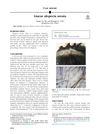TLDR Alopecia areata is caused by an immune response, and targeting immune cells might help treat it.
The study explored the pathogenesis of alopecia areata (AA) using a mouse model and human samples, identifying a cell-mediated immune response as a crucial factor. In C3H/HeJ mice, AA was induced through skin grafts, and gene expression analysis revealed 42 genes involved in early disease onset and 114 in later stages, indicating an inflammatory process. In humans, 95 genes were significantly modulated. Lymphocytes were confirmed as primary effector cells, and blocking T cell activation could prevent disease onset in mice. The study suggested that targeting immune cells might be effective in treating AA, highlighting the autoimmune nature of the disease and potential therapeutic targets.
77 citations
,
June 2002 in “Journal of Investigative Dermatology” CD44 variant changes start alopecia areata, but don't maintain it.
 41 citations
,
February 2001 in “Current pharmaceutical design”
41 citations
,
February 2001 in “Current pharmaceutical design” Current and future treatments for alopecia areata focus on immunosuppression, immunomodulation, and protecting hair follicles.
 131 citations
,
November 1998 in “The journal of investigative dermatology/Journal of investigative dermatology”
131 citations
,
November 1998 in “The journal of investigative dermatology/Journal of investigative dermatology” Skin grafts on mice can cause an immune response leading to hair loss, useful for studying human hair loss conditions.
71 citations
,
January 1998 in “Pathobiology” The document concludes that certain rats and mice are useful for studying hair loss in humans and testing treatments.
72 citations
,
September 1997 in “Journal of Investigative Dermatology” 178 citations
,
June 1994 in “Journal of Investigative Dermatology” Alopecia areata in these mice is inherited, more common in young females, and can be treated with triamcinolone acetonide.
 23 citations
,
April 1993 in “Gastroenterology”
23 citations
,
April 1993 in “Gastroenterology” A mother and son both had ulcerative colitis and alopecia, suggesting a genetic link in autoimmune disorders and successful treatment with cyclosporine.
78 citations
,
July 1984 in “Journal of Investigative Dermatology”
 148 citations
,
December 2018 in “Journal of autoimmunity”
148 citations
,
December 2018 in “Journal of autoimmunity” Alopecia areata is an autoimmune disease causing patchy hair loss, often with other autoimmune disorders, but its exact causes are unknown.
 4 citations
,
November 2018 in “JAAD case reports”
4 citations
,
November 2018 in “JAAD case reports” Alopecia areata can sometimes appear as a straight line of hair loss instead of round patches.
May 2018 in “Journal of cosmetology & trichology” Combining platelet-rich plasma therapy with prostaglandin-F eye drops can significantly regrow hair in alopecia universalis.





